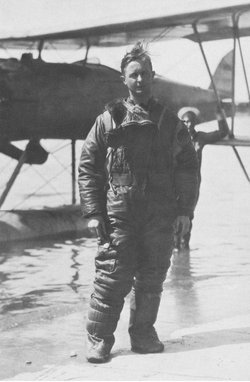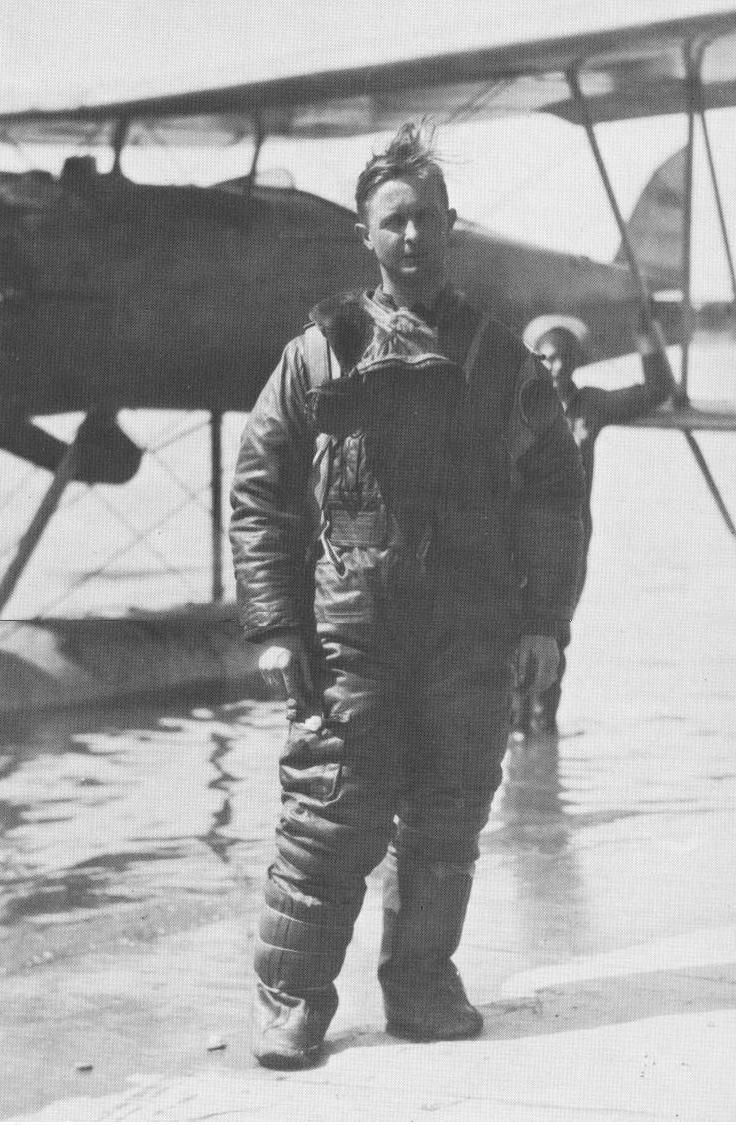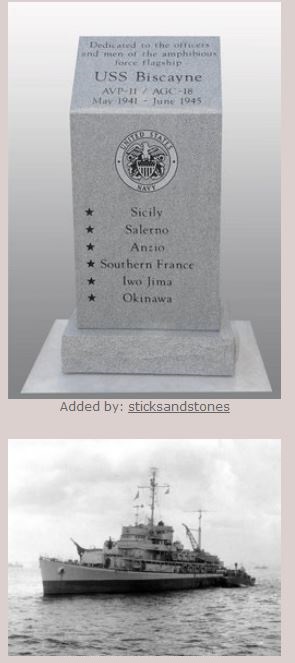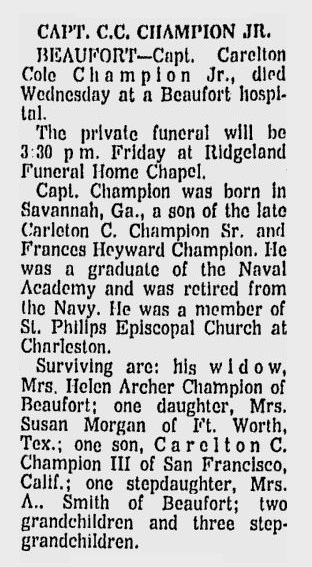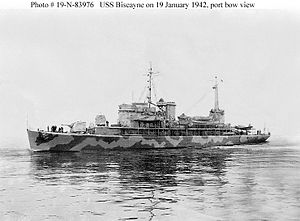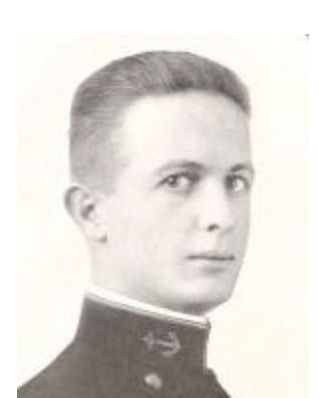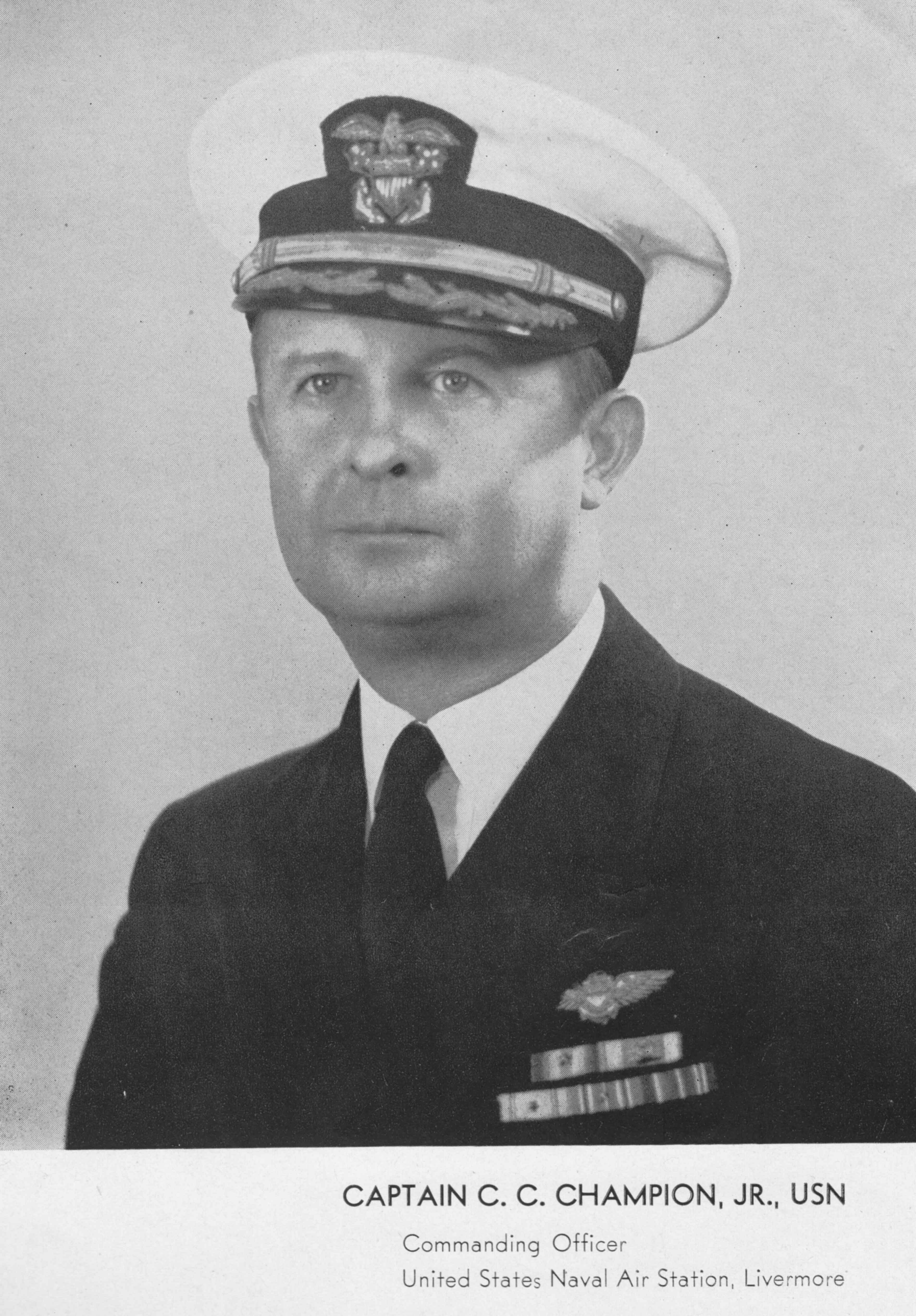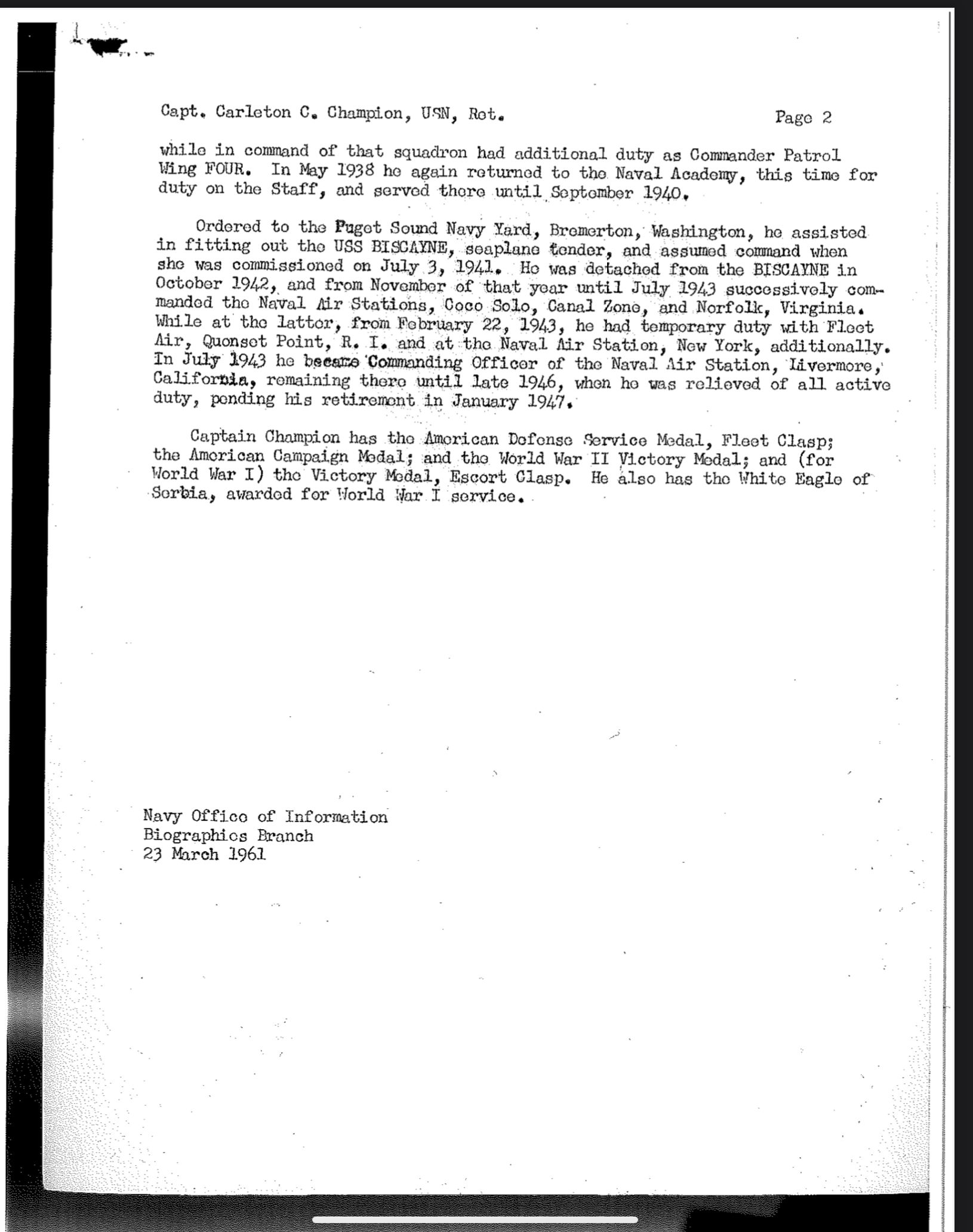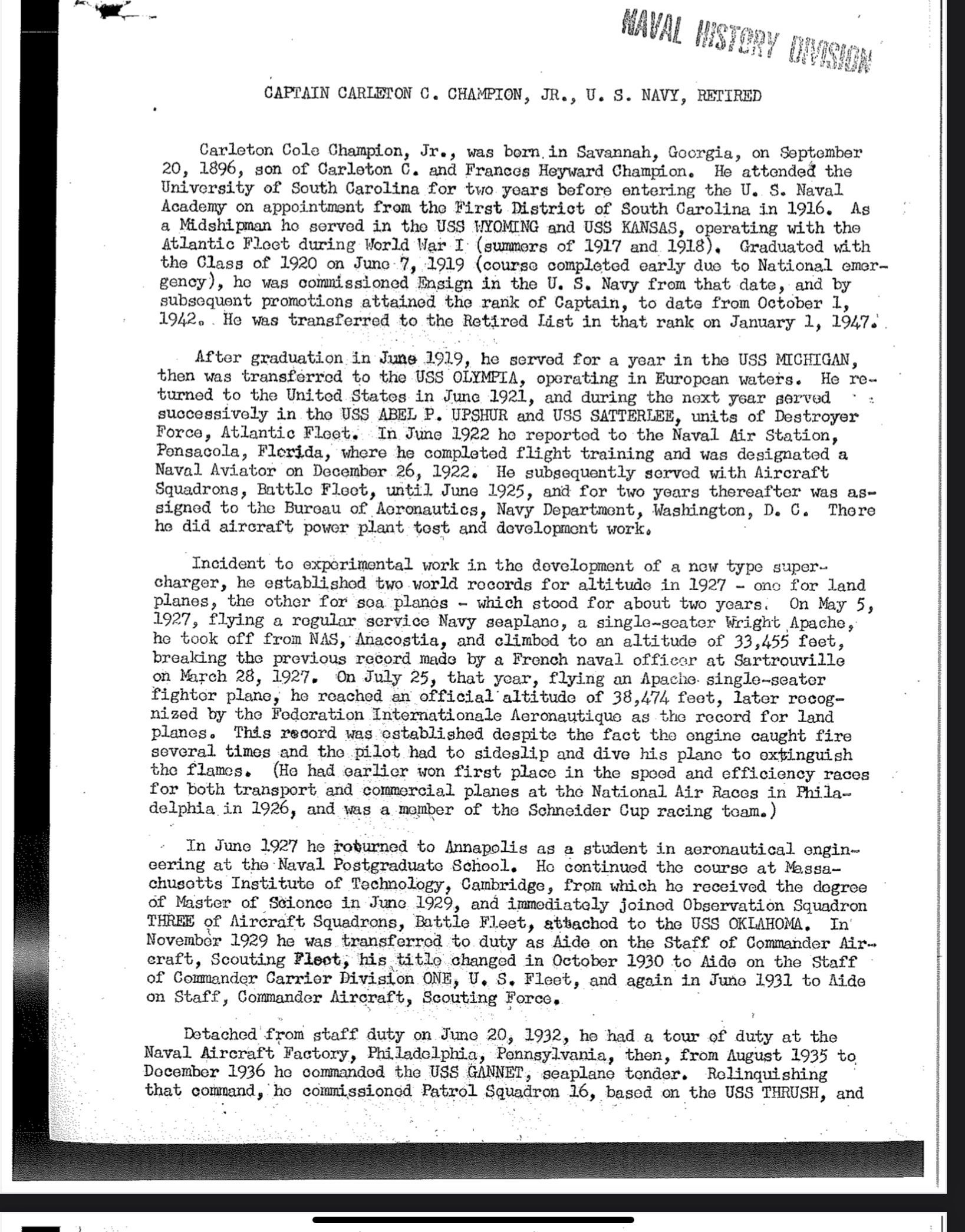Carleton spent his early years growing up in Savannah, but sometime before 1907, his family had moved to Mt Pleasant, SC, and later was shown living in Christ Church Township(near Mt. Pleasant), Charleston County,SC.
On March 20, 1920, he married Jeanne Andrews, daughter of Rear Admiral Philipp Andrews and Mrs. Clara Fuller Andrews, in Holy Trinity Church, Philadelphia, Pennsylvania. Captain and Mrs George W Laws were also recorded as witnesses.
Carleton and Jean had 3 sons, including Carleton Cole Champion III, who was born 8 Jul 1928, in Boston, Massachusetts, and passed away 15 Apr 1980 in San Francisco, San Mateo, California.
Jean passed away Dec. 18, 1960. Jean is buried in Arlington, with her parents. Carleton remarried, to Helen Elizabeth Archer, who passed away May 12, 2003. She is buried in Ridgeland Cemetery, Ridgeland, SC.
----------------------------------------
Military Service:
Lieutenant Commander Carleton Cole Champion,Jr was one of South Carolina's military heroes. He did much to advance Naval Aviation, in addition to his command of an Amphibious Seaplane Ship during World War II.
Carleton Champion enlisted in the United States Navy Jun 23, 1916.
In 1920, he is shown as assigned to the battleship USS Michigan (interestingly, a 'South Carolina Class' ship), which was based out of the Philadelphia Ship Yard.
June 23, 1923 he was admitted to the Second Class of Midshipmen of the US Naval Academy, Annapolis, MD.
September 21st, 1926 he applied for a patent with the U.S. Patent Office, for his invention of high tensile strength connecting rods for internal combustion engines.
"My invention relates broadly to internal combustion engines and more particularly to connecting rods therein. The principal object of my invention is to provide a master connecting rod of light alloy metal having a means for reinforcing the bearing portions, surrounding the crank shaft whereby the effect of tension load and stress reversals is minimized. This is especially desirable in a radial engine (aircraft motor) in which the articulated type of connecting rod is employed, and in which all but one of the crank shaft ends of the connecting rod are pinned to the master connecting rod."
[from Champion's patent]
Champion's Aviation Records:
May 5, 1927; Lieutenant Carleton C. Champion took off from Hampton Roads, Va., in a Wright Apache, equipped with a Pratt & Whitney Wasp engine and NACA supercharger, and climbed to an altitude of 33,455 feet, breaking the existing world record for Class C seaplanes by better than 3,000 feet.
July 4, 1927; Lieutenant Carleton C. Champion, flying a Wright Apache powered with a Pratt & Whitney engine, reached 37,995 feet over Anacostia, D.C., thereby breaking his own world altitude record for Class C seaplanes, established 2 months earlier. This height exceeded any previously reached by heavier-than- air aircraft.
July 25, 1927; Three weeks after breaking the seaplane altitude record, Lieutenant Carleton C. Champion took off from Anacostia, D.C., in a Wright Apache rigged as a landplane and reached 38,419 feet, establishing a new world record that stood for 2 years.
On July 22, 1930, He was issued patent 1771074 by the United States Government.
Champion was promoted to Commander of Livermore Naval Air Station (Livermore, CA) from 14 July 1943 to 27 October 1944.
His command, the USS Biscayne:
USS Biscayne (AVP-11), later AGC-18, was a United States Navy Barnegat-class seaplane tender in commission as a seaplane tender from 1941 to 1943 and as an amphibious force flagship from 1943 to 1946.
Construction and commissioning
Biscayne was laid down on 27 October 1939 at Puget Sound Navy Yard in Bremerton, Washington. She was launched on 23 May 1941, sponsored by Mrs. A. M. Charleton, and commissioned on 3 July 1941 with Lieutenant Commander C. C. Champion, Jr., in command.
Following her shakedown cruise, Biscayne joined the Atlantic Fleet and operated out of Boston, Massachusetts, on patrol and plane guard missions from 7 December 1941 until 27 May 1942. For the next four months she served as a seaplane tender and communications ship in Newfoundland and Greenland waters.
Biscayne departed Norfolk, Virginia, on 17 October 1942 and, after a short stop at Guantanamo Bay, Cuba, moved to Freetown, Sierra Leone, with Patrol Squadron 92 (VP-92), arriving on 2 November 1942.
Biscayne moved to Casablanca, French Morocco, on 18 November 1942 and remained there until 25 April 1943 supporting patrol squadrons.
Amphibious force flagship operations in the Mediterranean
Biscayne arrived at Mers-el-Kebir, Algeria, on 26 April 1943 and became the flagship of Rear Admiral Richard Lansing Conolly, Commander, Landing Craft and Bases, Northwest African Waters. While at Mers-el-Kebir she was fitted out as an amphibious force flagship by repair ship USS Delta (AR-9) between 2 May 1943 and 31 May 1943, although she retained her seaplane tender classification and AVP-11 designation for the time being. In May 1943, Biscayne shifted her moorings to Bizerte, Tunisia.
Departing Bizerte on 10 July 1943, Biscayne served as flagship of the Joss (Licata) Force in Operation Husky, the Allied invasion of Sicily. She remained off Sicily until 22 July 1943 and then returned to Bizerte.
Biscayne as an amphibious force flagship off Anzio on 21 January 1944 or 22 January 1944 during Operation Shingle. A PT boat is alongside her.
Beginning on 9 September 1943, Biscayne took part in Operation Avalanche, the Allied landings at Salerno, Italy, as flagship for Vice Admiral H. Kent Hewitt and Rear Admiral Conolly. While off Salerno, she escaped unscathed from frequent air and gunfire attacks. On 12 September 1943, she sent a fire and rescue team on board the British ammunition ship Lyminge and saved that vessel and her cargo of ammunition from destruction. Biscayne also served as a temporary hospital ship while off Salerno. Biscayne retired to Bizerte on 11 October 1943.
On 7 November 1943, Biscayne became the flagship of Rear Admiral F. J. Lowry, Commander, 8th Amphibious Force. Sailing for Italy once again, she served as flagship during Operation Shingle, the Allied landings at Anzio, from 22 January 1944 to 2 February 1944.
Biscayne became flagship of Rear Admiral B. J. Rodgers, Commander, Amphibious Group 2, 8th Amphibious Force, in May 1944. Between 15 August 1944 and 16 September 1944, she took part in Operation Dragoon, the Allied invasion of southern France.
On 10 October 1944, Biscayne was officially reclassified as a miscellaneous flagship and re-designated AGC-18.
Amphibious force flagship operations in the Pacific Theater
Biscayne left the Mediterranean on 12 October 1944 bound for Boston, and then steamed to the Pacific Ocean. She arrived at Pearl Harbor, Hawaii, on 9 January 1945 and became flagship of Captain Frederick Moosbrugger, Commander, Destroyer Squadron 63.
Biscayne took part in the invasion of Iwo Jima from 19 February 1945 to 4 March 1945 as flagship of the transport screen. she carried out similar duties during Operation Iceberg, the landings on Kerama Retto on 26 March 1945 and on Okinawa on 1 April 1945. She remained off Okinawa, supporting U.S. operations during and after the Okinawa campaign, until 1 July 1945, during which time she served as flagship for the occupation of Iheya and Aguni Islands between 3 June 1945 and 9 June 1945.
After her tour at Okinawa, Biscayne retired to Leyte in the Philippine Islands, and remained in the Philippines through the end of World War II, which concluded with the cessation of hostilities with Japan on 15 August 1945.
Awards
Biscayne received six battle stars for her World War II service
Captain Champion retired from military service, honorably discharged, September 30, 1946.
Carleton spent his early years growing up in Savannah, but sometime before 1907, his family had moved to Mt Pleasant, SC, and later was shown living in Christ Church Township(near Mt. Pleasant), Charleston County,SC.
On March 20, 1920, he married Jeanne Andrews, daughter of Rear Admiral Philipp Andrews and Mrs. Clara Fuller Andrews, in Holy Trinity Church, Philadelphia, Pennsylvania. Captain and Mrs George W Laws were also recorded as witnesses.
Carleton and Jean had 3 sons, including Carleton Cole Champion III, who was born 8 Jul 1928, in Boston, Massachusetts, and passed away 15 Apr 1980 in San Francisco, San Mateo, California.
Jean passed away Dec. 18, 1960. Jean is buried in Arlington, with her parents. Carleton remarried, to Helen Elizabeth Archer, who passed away May 12, 2003. She is buried in Ridgeland Cemetery, Ridgeland, SC.
----------------------------------------
Military Service:
Lieutenant Commander Carleton Cole Champion,Jr was one of South Carolina's military heroes. He did much to advance Naval Aviation, in addition to his command of an Amphibious Seaplane Ship during World War II.
Carleton Champion enlisted in the United States Navy Jun 23, 1916.
In 1920, he is shown as assigned to the battleship USS Michigan (interestingly, a 'South Carolina Class' ship), which was based out of the Philadelphia Ship Yard.
June 23, 1923 he was admitted to the Second Class of Midshipmen of the US Naval Academy, Annapolis, MD.
September 21st, 1926 he applied for a patent with the U.S. Patent Office, for his invention of high tensile strength connecting rods for internal combustion engines.
"My invention relates broadly to internal combustion engines and more particularly to connecting rods therein. The principal object of my invention is to provide a master connecting rod of light alloy metal having a means for reinforcing the bearing portions, surrounding the crank shaft whereby the effect of tension load and stress reversals is minimized. This is especially desirable in a radial engine (aircraft motor) in which the articulated type of connecting rod is employed, and in which all but one of the crank shaft ends of the connecting rod are pinned to the master connecting rod."
[from Champion's patent]
Champion's Aviation Records:
May 5, 1927; Lieutenant Carleton C. Champion took off from Hampton Roads, Va., in a Wright Apache, equipped with a Pratt & Whitney Wasp engine and NACA supercharger, and climbed to an altitude of 33,455 feet, breaking the existing world record for Class C seaplanes by better than 3,000 feet.
July 4, 1927; Lieutenant Carleton C. Champion, flying a Wright Apache powered with a Pratt & Whitney engine, reached 37,995 feet over Anacostia, D.C., thereby breaking his own world altitude record for Class C seaplanes, established 2 months earlier. This height exceeded any previously reached by heavier-than- air aircraft.
July 25, 1927; Three weeks after breaking the seaplane altitude record, Lieutenant Carleton C. Champion took off from Anacostia, D.C., in a Wright Apache rigged as a landplane and reached 38,419 feet, establishing a new world record that stood for 2 years.
On July 22, 1930, He was issued patent 1771074 by the United States Government.
Champion was promoted to Commander of Livermore Naval Air Station (Livermore, CA) from 14 July 1943 to 27 October 1944.
His command, the USS Biscayne:
USS Biscayne (AVP-11), later AGC-18, was a United States Navy Barnegat-class seaplane tender in commission as a seaplane tender from 1941 to 1943 and as an amphibious force flagship from 1943 to 1946.
Construction and commissioning
Biscayne was laid down on 27 October 1939 at Puget Sound Navy Yard in Bremerton, Washington. She was launched on 23 May 1941, sponsored by Mrs. A. M. Charleton, and commissioned on 3 July 1941 with Lieutenant Commander C. C. Champion, Jr., in command.
Following her shakedown cruise, Biscayne joined the Atlantic Fleet and operated out of Boston, Massachusetts, on patrol and plane guard missions from 7 December 1941 until 27 May 1942. For the next four months she served as a seaplane tender and communications ship in Newfoundland and Greenland waters.
Biscayne departed Norfolk, Virginia, on 17 October 1942 and, after a short stop at Guantanamo Bay, Cuba, moved to Freetown, Sierra Leone, with Patrol Squadron 92 (VP-92), arriving on 2 November 1942.
Biscayne moved to Casablanca, French Morocco, on 18 November 1942 and remained there until 25 April 1943 supporting patrol squadrons.
Amphibious force flagship operations in the Mediterranean
Biscayne arrived at Mers-el-Kebir, Algeria, on 26 April 1943 and became the flagship of Rear Admiral Richard Lansing Conolly, Commander, Landing Craft and Bases, Northwest African Waters. While at Mers-el-Kebir she was fitted out as an amphibious force flagship by repair ship USS Delta (AR-9) between 2 May 1943 and 31 May 1943, although she retained her seaplane tender classification and AVP-11 designation for the time being. In May 1943, Biscayne shifted her moorings to Bizerte, Tunisia.
Departing Bizerte on 10 July 1943, Biscayne served as flagship of the Joss (Licata) Force in Operation Husky, the Allied invasion of Sicily. She remained off Sicily until 22 July 1943 and then returned to Bizerte.
Biscayne as an amphibious force flagship off Anzio on 21 January 1944 or 22 January 1944 during Operation Shingle. A PT boat is alongside her.
Beginning on 9 September 1943, Biscayne took part in Operation Avalanche, the Allied landings at Salerno, Italy, as flagship for Vice Admiral H. Kent Hewitt and Rear Admiral Conolly. While off Salerno, she escaped unscathed from frequent air and gunfire attacks. On 12 September 1943, she sent a fire and rescue team on board the British ammunition ship Lyminge and saved that vessel and her cargo of ammunition from destruction. Biscayne also served as a temporary hospital ship while off Salerno. Biscayne retired to Bizerte on 11 October 1943.
On 7 November 1943, Biscayne became the flagship of Rear Admiral F. J. Lowry, Commander, 8th Amphibious Force. Sailing for Italy once again, she served as flagship during Operation Shingle, the Allied landings at Anzio, from 22 January 1944 to 2 February 1944.
Biscayne became flagship of Rear Admiral B. J. Rodgers, Commander, Amphibious Group 2, 8th Amphibious Force, in May 1944. Between 15 August 1944 and 16 September 1944, she took part in Operation Dragoon, the Allied invasion of southern France.
On 10 October 1944, Biscayne was officially reclassified as a miscellaneous flagship and re-designated AGC-18.
Amphibious force flagship operations in the Pacific Theater
Biscayne left the Mediterranean on 12 October 1944 bound for Boston, and then steamed to the Pacific Ocean. She arrived at Pearl Harbor, Hawaii, on 9 January 1945 and became flagship of Captain Frederick Moosbrugger, Commander, Destroyer Squadron 63.
Biscayne took part in the invasion of Iwo Jima from 19 February 1945 to 4 March 1945 as flagship of the transport screen. she carried out similar duties during Operation Iceberg, the landings on Kerama Retto on 26 March 1945 and on Okinawa on 1 April 1945. She remained off Okinawa, supporting U.S. operations during and after the Okinawa campaign, until 1 July 1945, during which time she served as flagship for the occupation of Iheya and Aguni Islands between 3 June 1945 and 9 June 1945.
After her tour at Okinawa, Biscayne retired to Leyte in the Philippine Islands, and remained in the Philippines through the end of World War II, which concluded with the cessation of hostilities with Japan on 15 August 1945.
Awards
Biscayne received six battle stars for her World War II service
Captain Champion retired from military service, honorably discharged, September 30, 1946.
